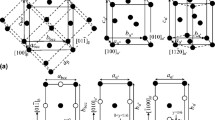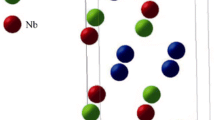Abstract
The effect of oxygen on phase stability and β–α″ martensitic transformation in Ti–Nb alloys has been studied using first principles calculations. Three stable atomic configurations of Ti–Nb (Ti-12.5, 16.6, and 25 at.% Nb) systems, which can transform from β-phase to α″-phase without changing the local atomic position of Nb atoms, were first identified using the cluster expansion method. Phonon calculations indicated that these structures were stable. Next, the martensitic transformation behavior of Ti–Nb–O system was studied using these structures. We observed a significant lattice distortion around oxygen atoms occupying octahedral interstitial sites that resembles a bcc type of stacking. Our results conclusively revealed that while the oxygen interstitials can oppose the atomic shuffle required for martensitic transformation, they can also cooperatively stabilize the β-phase even at 1 at.% oxygen concentrations by inducing local elastic shear strains. Interestingly, the canceling of these fields can stabilize the β-phase by suppressing the β to α″ transformation which decreases the martensitic start temperature (Ms). Our study revealed that the reduction in Ms is higher at lower Nb concentration. The stabilization of β-phase increases with oxygen concentration.











Similar content being viewed by others
References
Hao YL, Li SJ, Sun SY, Zheng CY, Yang R (2007) Elastic deformation behaviour of Ti–24Nb–4Zr–7.9Sn for biomedical applications. Acta Biomater 3(2):277–286
Shabalovskaya S (1994) Shape memory and superelastic technologies. In: First International Conference, p 209
Takahashi E, Sakurai T, Watanabe S, Masahashi N, Hanada S (2002) Effect of heat treatment and Sn content on superelasticity in biocompatible TiNbSn alloys. Mater Trans 43(12):2978–2983
Bönisch M, Calin M, Waitz T, Panigrahi A, Zehetbauer M, Gebert A, Skrotzki W, Eckert J (2013) Thermal stability and phase transformations of martensitic Ti–Nb alloys. Sci Technol Adv Mater 14(5):55004
Hao YL, Li SJ, Prima F, Yang R (2012) Controlling reversible martensitic transformation in titanium alloys with high strength and low elastic modulus. Scr Mater 67:487–490
All EBV, With I (2017) Stabilizing the body centered cubic crystal in titanium alloys by a nano-scale concentration modulation. J Alloys Compd 700:155–158
Kim HY, Ikehara Y, Kim JI, Hosoda H, Miyazaki S (2006) Martensitic transformation, shape memory effect and superelasticity of Ti–Nb binary alloys. Acta Mater 54(9):2419–2429
Kim JI, Kim HY, Inamura T, Hosoda H, Miyazaki S (2005) Shape memory characteristics of Ti–22Nb–(2–8) Zr(at.%) biomedical alloys. Mater Sci Eng A 403(1–2):334–339
Hao YL, Li SJ, Sun SY, Yang R (2006) Effect of Zr and Sn on Young’s modulus and superelasticity of Ti–Nb-based alloys. Mater Sci Eng A 441(1–2):112–118
Kim HY, Sasaki T, Okutsu K, Kim JI, Inamura T, Hosoda H, Miyazaki S (2006) Texture and shape memory behavior of Ti–22Nb–6Ta alloy. Acta Mater 54(2):423–433
Masumoto K, Horiuchi Y, Inamura T, Hosoda H, Wakashima K, Kim HY, Miyazaki S (2006) Effects of Si addition on superelastic properties of Ti–Nb–Al biomedical shape memory alloys. Mater Sci Eng A 438–440:835–838
Nayak SK, Hung CJ, Sharma V, Alpay SP, Dongare AM, Brindley WJ, Hebert RJ (2018) Insight into point defects and impurities in titanium from first principles. npj Comput Mater 4(1):11
Il Kim J, Kim HY, Hosoda H, Miyazaki S (2005) Shape memory behavior of Ti–22Nb–(0.5–2.0) O (at%) biomedical alloys. Mater Trans 46(4):852–857
Nii Y, Arima TH, Kim HY, Miyazaki S (2010) Effect of randomness on ferroelastic transitions: disorder-induced hysteresis loop rounding in Ti–Nb–O martensitic alloy. Phys Rev B Condens Matter Mater Phys 82(21):1–7
Tahara M, Kim HY, Inamura T, Hosoda H, Miyazaki S (2011) Lattice modulation and superelasticity in oxygen-added β-Ti alloys. Acta Mater 59(16):6208–6218
Tahara M, Inamura T, Kim HY, Miyazaki S, Hosoda H (2015) Role of oxygen atoms in α″ martensite of Ti-20 at.% Nb alloy. Scr Mater 112:15–18
Saito T (2003) Multifunctional alloys obtained via a dislocation-free plastic deformation mechanism. Science 300(5618):464–467
Tane M, Nakano T, Kuramoto S, Niinomi M, Takesue N, Nakajima H (2013) ω Transformation in cold-worked Ti–Nb–Ta–Zr–O alloys with low body-centered cubic phase stability and its correlation with their elastic properties. Acta Mater 61(1):139–150
Sun J, Yao Q, Xing H, Guo WY (2007) Elastic properties of β, α″ and ω metastable phases in Ti–Nb alloy from first-principles. J Phys Condens Matter 19(48):486215
Ojha A, Sehitoglu H (2016) Slip resistance of Ti-based high-temperature shape memory alloys. Shape Mem Superelasticity 2(1):50–61
Minami D (2016) Effect of alloying element X on transformation strains and phase stabilities between alpha double prime and beta Ti–Nb–X (X = Al, Sn, Zr, Ta) ternary alloys. Mater Trans 57(3):263–268
Niu JG, Ping DH, Ohno T, Geng WT (2014) Suppression effect of oxygen on the β to ω transformation in a β-type Ti alloy: insights from first-principles. Model Simul Mater Sci Eng 22(1):15007
Hennig RG, Trinkle DR, Bouchet J, Srinivasan SG, Albers RC, Wilkins JW (2005) Impurities block the alpha to omega martensitic transformation in titanium. Nat Mater 4(2):129–133
Niu JG, Geng WT (2014) Oxygen-induced lattice distortion in β–Ti3Nb and its suppression effect on β to α’’ transformation. Acta Mater 81:194–203
Blöchl PE (1994) Projector augmented-wave method. Phys Rev B 50(24):17953–17979
Perdew JP, Burke K, Ernzerhof M (1996) Generalized gradient approximation made simple. Phys Rev Lett 77(18):3865–3868
Materials Design (2012) Medea version 2.10 (Angel Fire, NM Mater Des)
Lerch D, Wieckhorst O, Hart GLW, Forcade RW, Müller S (2009) UNCLE: a code for constructing cluster expansions for arbitrary lattices with minimal user-input. Model Simul Mater Sci Eng 17(5):55003
van de Walle A (2008) A complete representation of structure-property relationships in crystals. Nat Mater 7(6):455–458
Sheppard D, Xiao P, Chemelewski W, Johnson DD, Henkelman G (2012) A generalized solid-state nudged elastic band method. J Chem Phys 136(7):074103
Lazar P, Jahnátek M, Hafner J, Nagasako N, Asahi R, Blaas-Schenner C, Stöhr M, Podloucky R (2011) Temperature-induced martensitic phase transitions in gum-metal approximants: first-principles investigations for Ti3Nb. Phys Rev B Condens Matter Mater Phys 84(5):1–17
Togo A, Tanaka I (2015) First principles phonon calculations in materials science. Scr Mater 108:1–5
Trinkle DR, Jones MD, Hennig RG, Rudin SP, Albers RC, Wilkins JW (2006) Empirical tight-binding model for titanium phase transformations. Phys Rev B Condens Matter Mater Phys 73(9):1–9
Souvatzis P, Eriksson O, Katsnelson MI, Rudin SP (2008) Entropy driven stabilization of energetically unstable crystal structures explained from first principles theory. Phys Rev Lett 100(9):1–4
Souvatzis P, Arapan S, Eriksson O, Katsnelson M (2011) Temperature driven α to β phase-transformation in Ti, Zr and Hf from first principles theory combined with lattice dynamics. Condmat 66006(1):4
Yu L, Yin F, Ping D (2007) Natural mechanism of the broadened Snoek relaxation profile in ternary body-centered-cubic alloys. Phys Rev B Condens Matter Mater Phys 75(17):1–12
Wu HH, Wisesa P, Trinkle DR (2013) Oxygen diffusion in HCP metals. Phys Rev B 14307:1–15
Nowick AS, Berry BS (1972) Anelastic relaxation in crystaline solids. Academic, New York
Kim HY, Ohmatsu Y, Il Kim J, Hosoda H, Miyazaki S (2004) Mechanical properties and shape memory behavior of Ti–Mo–Ga alloys. Mater Trans 45(4):1090–1095
Miyazaki S, Kim HY, Hosoda H (2006) Development and characterization of Ni-free Ti-base shape memory and superelastic alloys. Mater Sci Eng A 438–440:18–24
Tahara M, Kanaya T, Kim HY, Inamura T, Hosoda H, Miyazaki S (2014) Heating-induced martensitic transformation and time-dependent shape memory behavior of Ti–Nb–O alloy. Acta Mater 80:317–326
Duerig TW, Williams JC (1984) Overview: microstructure and properties of beta titanium alloys. In: Proceedings of the symposium on beta titanium alloys in the 80’s, TMS, Atlanta, GA, pp 16–67
Ojha A, Sehitoglu H (2016) Critical stresses for twinning, slip, and transformation in Ti-based shape memory alloys. Shape Mem Superelasticity 2:180–195
Bonisch M, Calin M, Giebeler L, Helth A, Gebert A, Skrotzki W, Eckert J (2014) Composition-dependent magnitude of atomic shuffles in Ti–Nb martensites. J Appl Crystallogr 47(4):1374–1379
Yuan B, Yang B, Gao Y, Lai M, Chen XH, Zhu M (2016) Achieving ultra-high superelasticity and cyclic stability of biomedical Ti–11Nb–4O (at.%) alloys by controlling Nb and oxygen content. Mater Des 92:978–982
Acknowledgements
This research was supported by the NSF DEMREF program (Grant Number 1435611). The computations were done on Talon3 supercomputer at the University of North Texas and TACC Stampede2 at Texas Advanced Computing Center through XSEDE program.
Author information
Authors and Affiliations
Corresponding author
Rights and permissions
About this article
Cite this article
Salloom, R., Reith, D., Banerjee, R. et al. First principles calculations on the effect of interstitial oxygen on phase stability and β–α″ martensitic transformation in Ti–Nb alloys. J Mater Sci 53, 11473–11487 (2018). https://doi.org/10.1007/s10853-018-2381-6
Received:
Accepted:
Published:
Issue Date:
DOI: https://doi.org/10.1007/s10853-018-2381-6




